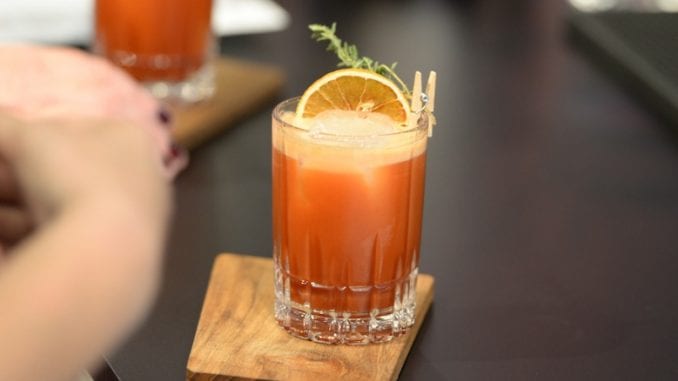
In the first installment of this two-part series, the fourth- through sixth-place finishers of the coffee-and-alcohol competition share their recipes and thoughts from this year’s contest on the world’s stage.
BY CHRIS RYAN
BARISTA MAGAZINE ONLINE
Photos courtesy of Jordan Sanchez for World Coffee Events
Those familiar with barista competitions know the old rule about the signature drink: Be as creative and forward-thinking as you want with the ingredients you use, but no alcohol allowed. With the Coffee in Good Spirits competition, that rule is thrown out the window as baristas battle to see who can create the best combinations of coffee and alcohol.
At the recent World Coffee in Good Spirits Championship in Budapest, Hungary, competitors made seemingly endless coffee-and-booze beverages—new takes on classics, inventive creations, and much in between. In the preliminary round, competitors produced four drinks: two identical hot coffee-and-alcohol-based designer drinks, and two identical cold drinks. In the finals, competitors produced two Irish coffees and two coffee-and-alcohol-based designer drinks. We asked the six finalists to pick their favorite drink they made during the competition, and share their approach and the recipe. In part one we hear from finishers four through six, and part two will feature the top three.
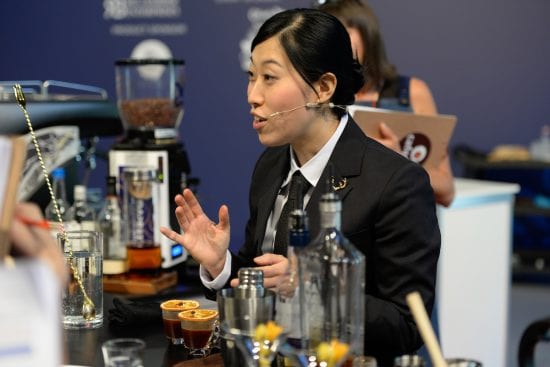
Sixth place—Yukari Suzuki of Japan
What was your favorite drink you made in the competition? Why?
My favorite drink was a cold designer cocktail because I think it best showcases the high-quality acidity of specialty coffee. The flavor of the drink is a bright orange, and the acidity—which reminds us of a bright orange—comes from my coffee. It was a very juicy and refreshing drink, so I hoped all the judges enjoyed my drinks in early summer of Budapest!
What was your inspiration for this drink?
My inspiration comes from the acidity of my coffee. My coffee was Colombian Geisha from the Cerro Azul farm. The Geisha variety tends to have a high acidity like a lemon, but my Cerro Azul Geisha has super-sweet acidity like an orange. So I wanted to fully use the sweet and beautiful bright acidity of my coffee.
How did you choose the coffee for this drink?
We would like a coffee with clear, bright, and sweet acidity like fresh fruits, because we believe the high-quality acidity of specialty coffee can perform an important role as fresh fruits in coffee cocktails, as if mixology bartenders use the sweetness and acidity of fresh fruits when making cocktails. We tried many kinds of Geisha coffee, but this Cerro Azul has the clearest, brightest, and sweetest acidity like fresh oranges.
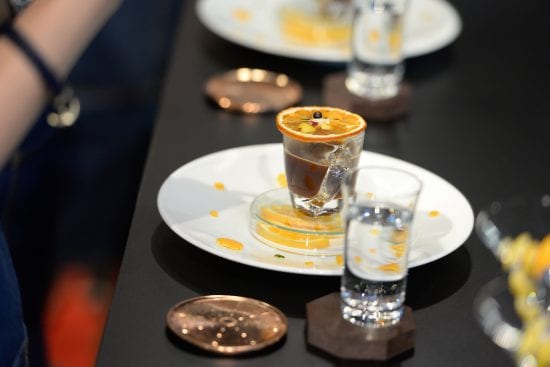
What was your recipe for this drink?
50ml Ron Zacapa rum
45g Cerro Azul espresso
15ml simple sugar syrup
35ml Pectin
Stir all the ingredients in the mixing glass with ice cubes made of soft water. Dilute with 100ml of water from the ice. Pour into glasses and squeeze orange peel for a citrus aroma note. Makes two drinks.
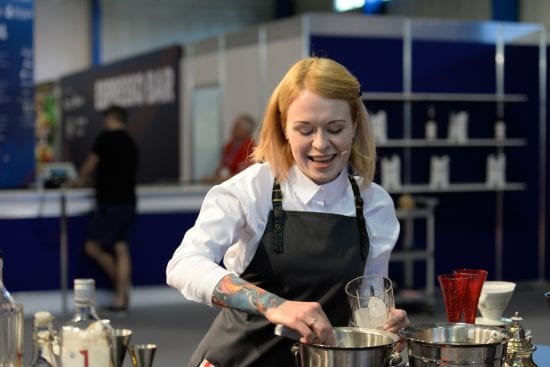
Fifth place—Natalia Obruch of Russia
What was your favorite drink you made in the competition? Why?
Well, I’d say that my very favorite drink was served during the preliminary round: a cold beverage, based on Jensen’s gin, espresso, pomegranate syrup, and rose lemonade. If choosing between the drinks on the finals—hmmm. Could that be Irish coffee? 🙂 It was my favorite because it was complex, well-balanced: sweet, medium bitter, just a little acidic, yet it had a very pleasant texture and a memorable serving.
What was your inspiration for this drink?
My whole preliminary stage presentation was inspired by Alice in Wonderland. I made a “mad tea”—of course!—as my warm beverage. The cold beverage I made did not really exist in the book, but it could have been a “Desert Rose Champagne for the Queen Of Hearts.”
How did you choose the coffee for this drink?
I needed a bright, sweet, and berry-like coffee with a strong body—most likely a natural processed coffee—so I ended up using Colombian natural processed coffee from the La Claudine farm in the Antioquia region.
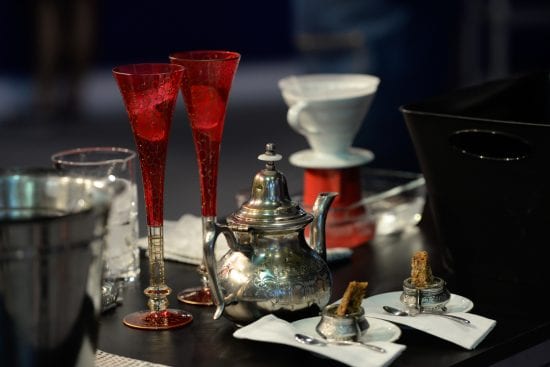
What was your recipe for this drink?
4 espresso shots (filtered out of crema)
25ml pomegranate syrup
40ml Jensen’s gin
Mixed in a mixing glass. Topped with 100ml rose lemonade. Makes two drinks.
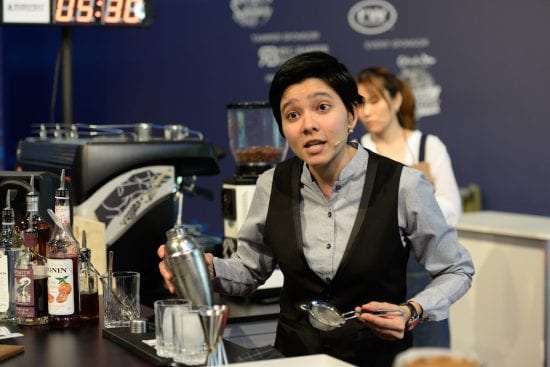
Fourth place—Natasha Shariff of Singapore
What was your favorite drink you made in the competition? Why?
My favorite drink would be Jensen’s Summer, which was my cold cocktail that was showcased for the preliminaries as well as the finals. It is a gin-based cocktail. Ultimately Jensen’s Summer really encapsulated what a summer drink would be like if I had to imagine or create one: refreshing, vibrant, complex with notes of cherries, a sparkling mouthfeel with notes of caramel and chocolate from the coffee that I used, and undertones of botanicals from the gin. It’s a nice and cold cocktail that’s just the thing you would want to cool down with on a hot summer day.
What was your inspiration for this drink?
I took the inspiration of it being summertime and using as many fresh ingredients as possible. Once I found out that gin was going to be one of the sponsored spirits, I knew that it would be more approachable as a cold cocktail as opposed to a hot one. Gin also has a much nicer texture and mouthfeel when it’s cold, and less harsh in terms of the botanical flavors that are present, so you end up either liking or hating it when you drink gin. I also used fresh red grapes, dehydrated orange, grapefruit peel, and fresh thyme—enhancing the botanicals rather than trying to mask them with other flavors.
How did you choose the coffee for this drink?
I thought of using many different coffees for this competition. But ultimately it was not a typical price issue, or accessibility to get a good coffee. I chose to work with a very typical Guatemalan coffee that was sourced from a company that we have been working with and produced by the same family for the last 12 years—Finca El Gigante in Chiquimula, Guatemala, that is run by the Oswalso Suchini family. Its a washed coffee that’s grown at 1,500 meters above sea level and is a mixed-batched varietal that presents flavors that are comforting and familiar: cherries, chocolate, and caramel. This coffee was versatile and easy to work with on many spirits. This made the decision a lot easier to choose it as the final coffee to work with.
What was your recipe for this drink?
1 double shot of Guatemala Finca El Gigante Espresso (21gm in, yield 42 out)
The espresso shot should be cooled down in an ice bath briefly
60ml Jensen’s Bermondsey gin
20ml Sipsmith Sloe gin
20ml Monin Blood Orange syrup
6-7 fresh red grapes (muddle in a shaker to break it up)
Place all remaining spirits, syrup, and espresso into a medium-sized shaker plus two large ice cubes to reduce dilution. Shake vigorously to aerate and incorporate all ingredients—should be icy cold! Double strain and pour out into 2x nice rocks glass with 1x large ice cube. Finish with grapefruit peel (twist to release oils on surface of drink). Garnish with dehydrated orange and fresh thyme sprig. Makes two drinks.

